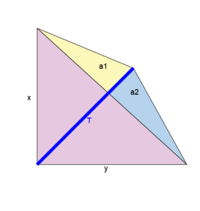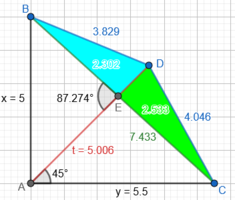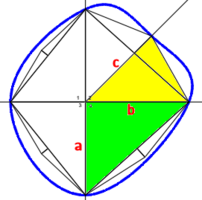You are using an out of date browser. It may not display this or other websites correctly.
You should upgrade or use an alternative browser.
You should upgrade or use an alternative browser.
Area of unknown triangle: if I ALWAYS know the length of x, y and T, how do I calculate the areas of a1 and a2?
- Thread starter robarb
- Start date
Dr.Peterson
Elite Member
- Joined
- Nov 12, 2017
- Messages
- 16,117
Do you know anything more than is explicitly shown, such as that these are right angles?Hello, new here. I'm wondering, if I ALWAYS know the length of x, y and T, how do I calculate the areas of a1 and a2?
Thanks
View attachment 36216
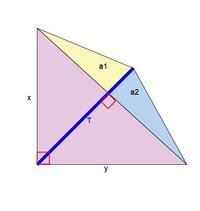
Also, please show us whatever you have tried, so we don't duplicate your efforts. Our goal is to help you solve it, not just do it for you (assuming your goal is to learn something):
Posting Guidelines (Summary)
Welcome to our tutoring boards! :) This page summarizes the main points from our posting guidelines. As our name implies, we provide math help (primarily to students with homework). We do not generally post immediate answers or step-by-step solutions. We don't do your homework. We prefer to...
www.freemathhelp.com
Sorry, Thanks for your reply but i should have also mentioned that T will always bisect the hypotenuse of xy and will always be at 45 degrees from the corner of xy.
I'm struggling because i assumed the angle where T bisects the hypotenuse would create a 90 degree right angled triangle, but it doesn't.
I'm struggling because i assumed the angle where T bisects the hypotenuse would create a 90 degree right angled triangle, but it doesn't.
So...
x=5
y=5.5
T=5
to get the hypotenuse
5(2) + 5.5(2) = hyp(2) = 7.433
From that, i can get the angles of the two pinkish triangles using cos > (bottom triangle 45, 42 and 93) (top triangle 45, 48 and 87)
So you see, at the bisect the angles are 87 and 93, not 90. I can;t remember how to get the two lengths of the bisected hypotenuse so then am stuck on the areas of a1 and a2
x=5
y=5.5
T=5
to get the hypotenuse
5(2) + 5.5(2) = hyp(2) = 7.433
From that, i can get the angles of the two pinkish triangles using cos > (bottom triangle 45, 42 and 93) (top triangle 45, 48 and 87)
So you see, at the bisect the angles are 87 and 93, not 90. I can;t remember how to get the two lengths of the bisected hypotenuse so then am stuck on the areas of a1 and a2
- Joined
- Feb 4, 2004
- Messages
- 16,582
....T will always bisect the hypotenuse of xy and will always be at 45 degrees from the corner of xy.
Will T be 45 degrees above side y, or 45 degrees to the right of side x? (Unless the angle at the point where side x and side y is 90 degrees, then only one of the angles formed by T can be 45 degrees.)
I'm struggling because i assumed the angle where T bisects the hypotenuse would create a 90 degree right angled triangle, but it doesn't.
When side x and side y have different lengths, then the bisector of the hypotenuse cannot meet that hypotenuse at a 90-degree angle.
Is there any other additional information for this set-up? Thank you!
Dr.Peterson
Elite Member
- Joined
- Nov 12, 2017
- Messages
- 16,117
Your assumptions conflict with one another; they can only both be true when x=y. So we need better information about your real needs. Perhaps only one of the two facts (bisecting, which means passing through the midpoint, and 45 degrees) is true.Sorry, Thanks for your reply but i should have also mentioned that T will always bisect the hypotenuse of xy and will always be at 45 degrees from the corner of xy.
I'm struggling because i assumed the angle where T bisects the hypotenuse would create a 90 degree right angled triangle, but it doesn't.
Can you tell us the backstory? What is the real situation you are modeling?
A better notation for squares is "5^2"; your calculation is [math]hyp^2=5^2+5.5^2=55.25\\hyp=\sqrt{55.25}\approx7.433[/math] which you could type as5(2) + 5.5(2) = hyp(2) = 7.433
hyp^2 = 5^2+5.5^2 = 55.25
hyp = sqrt(55.25) = 7.433
Thanks @Dr.Peterson. Yes, your notation is better! I couldn't find out how to insert those symbols.
@stapel, again poor terminology on my part. Bisect is incorrect, i should just have said crosses at a certain point P in my updated diagram.
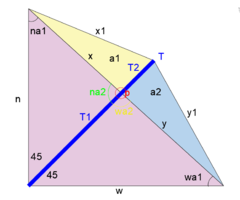
I also think i'm getting there, albeit a little long winded. Also, n and w (sorry for the notation change) are not always the same length. I've also seen the use of SOHCAHTOA in my searches so that's helped.
So, n=5, w=5.5, T=5, x+y = hyp
hyp^2 = n^2 + w^2 = 55.25
hyp = (sqrt)55.25 = 7.433
Knowing the n/w corner is ALWAYS a right angle, then we can work out wa1 angle and na1 angle
for wa1: sin(wa1) = n/hyp = 0.6727
wa1 = sin^-1(0.6727)
wa1 = 42.28 degrees
for na1: sin(na1) = w/hyp = 0.7399
na1 = sin^-1(0.7399)
na1 = 47.72 degrees
(42.28 + 47.72 + 90 = 180 degrees)
So, for getting the na2 and wa2, that's easy as we know 3 angles in a triangle add up to 180
na2 = 87.28
wa2 = 92.72
I've also not annotated the angles opposite na2 and wa2 but again, easy as they will be the same.
So, for shape a1 i know need at least the lengths of x and T2. to get x, is this the Law of Sines? But i'm struggling:
sin 45/x = (sin(tan^-1(w/n))/T1)
Is this where i'm going wrong?
If i can get x (and y), i think i can then get T1, and subsequently T2 (T-T1=T2). and then in theory if i have x, T2 and the angle opposite wa2, i can calculate area a1!?
Any further guidance?
This is all really helpful. The ultimate aim is to calculate approximate tree canopy area based on 8 cardinal points (don't ask lol). I will be using excel as my ultimate calculator once i know the maths in my head.
@stapel, again poor terminology on my part. Bisect is incorrect, i should just have said crosses at a certain point P in my updated diagram.

I also think i'm getting there, albeit a little long winded. Also, n and w (sorry for the notation change) are not always the same length. I've also seen the use of SOHCAHTOA in my searches so that's helped.
So, n=5, w=5.5, T=5, x+y = hyp
hyp^2 = n^2 + w^2 = 55.25
hyp = (sqrt)55.25 = 7.433
Knowing the n/w corner is ALWAYS a right angle, then we can work out wa1 angle and na1 angle
for wa1: sin(wa1) = n/hyp = 0.6727
wa1 = sin^-1(0.6727)
wa1 = 42.28 degrees
for na1: sin(na1) = w/hyp = 0.7399
na1 = sin^-1(0.7399)
na1 = 47.72 degrees
(42.28 + 47.72 + 90 = 180 degrees)
So, for getting the na2 and wa2, that's easy as we know 3 angles in a triangle add up to 180
na2 = 87.28
wa2 = 92.72
I've also not annotated the angles opposite na2 and wa2 but again, easy as they will be the same.
So, for shape a1 i know need at least the lengths of x and T2. to get x, is this the Law of Sines? But i'm struggling:
sin 45/x = (sin(tan^-1(w/n))/T1)
Is this where i'm going wrong?
If i can get x (and y), i think i can then get T1, and subsequently T2 (T-T1=T2). and then in theory if i have x, T2 and the angle opposite wa2, i can calculate area a1!?
Any further guidance?
This is all really helpful. The ultimate aim is to calculate approximate tree canopy area based on 8 cardinal points (don't ask lol). I will be using excel as my ultimate calculator once i know the maths in my head.
Dr.Peterson
Elite Member
- Joined
- Nov 12, 2017
- Messages
- 16,117
This suggests that you don't literally mean bisect (divide into two equal parts). Perhaps you meant only that line T bisects the right angle BAC, which agrees with the 45 degree angle.From that, i can get the angles of the two pinkish triangles using cos > (bottom triangle 45, 42 and 93) (top triangle 45, 48 and 87)
So you see, at the bisect the angles are 87 and 93, not 90. I can;t remember how to get the two lengths of the bisected hypotenuse so then am stuck on the areas of a1 and a2
In that case, the angle bisector theorem tells you the lengths of the two parts of the hypotenuse, BE and EC.
Can you show us how you got the angles, and anything else you know about trigonometry? I was assuming meant that you were using the definition of cosine, but that would only work if you did assume a right angle, and you didn't.
You can use the law of cosines to find BD and CD, and there are various things you can do to find the areas, depending on what you have learned.
Hello, I'm in the UK there is obviously a time difference.
Thanks for your post. You are correct, I keep saying bisected and that is incorrect. Line T can cross the hyp at any point. This is defined by the lengths of x, y and T. Is suppose visually, it would help if my measurements were different by more than 0.5 so you can see that T is not a bisection of hyp xy. In the example on the left, n=3, w=7 and T=4.5, Line T is set at 45 degrees (and always is).
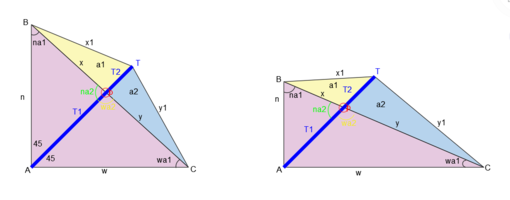
In the example I will always KNOW the following values:
n, w and T.
I also will always know that line T will always be at 45 degrees and the pink shaded triangle will always be right-angled. The main point of the task is to get areas a1 and a2. My trig knowledge is basic at best but I have started to remind myself of how to get the angles of a right-angled triangle (I also know that the 3 angles in any triangle regardless of shape add up to 180degrees) using pythagoras and cosine, sine and tan.
Using the new example on the right.
n=3
w=7
T=4.5
angle at point A = 90 degrees, Line T set to 45 degrees.
xy^2 = n^2 + w^2
xy^2 = 3^2 + 7^2
xy^2 = 9 + 49 = 58
xy = (sqrt)58 = 7.6158
Using the trig: Sine, Cosine or Tangent, to get angle wa1:
for wa1: sin(wa1) = n/hyp = 0.3939
wa1 = sin^-1(0.3939)
wa1 = 23.1974 degrees
for na1: sin(na1) = w/hyp = 0.9191
na1 = sin^-1(0.9191)
na1 = 66.7949 degrees
All 4 angles at point P will add up to 360 degrees. All 3 angles in a triangle add up to 180 degrees. I can then work out wa2 and na2, which are:
na2: 68.2051 degrees
wa2: 111.8026 degrees
Ok, here goes, Triangle ABT is scalene (so is ATC). The Law of Cosines says a^2=b^2 + c^2 - 2bc cos(A), where A is the angle opposite to the third side (a)
AB=n=3
BT=x1=?
AT=T=4.5
x1^2 = n^2 + T^2 - 2nT cos(A)
x1^2 = 3^2 + 4.5^2 - (2*3*4.5 * cos (45))
x1^2 = 9 + 20.25 - 27 * 0.7071
x1^2 = 29.25 - 19.0919
x1^2 = 11.1843
x1 = (sqrt)10.1581
x1 = 3.1872
so i now have the values of n and w, i need to find x and y. - Using Angle Bisector Theorem
w/n = y/x
let y = 'length', then x = 7.6518-'length'
7 = length
3 7.6518-length
7(7.6518-length) = 3length
53.5626-7length = 3length
53.5626 = 7length + 3length
53.5626 = 10length
5.3562 = length = y
I know this is incorrect though as i know y = 5.3310 ( i can measure it!) so where am i going wrong??
Thanks for your post. You are correct, I keep saying bisected and that is incorrect. Line T can cross the hyp at any point. This is defined by the lengths of x, y and T. Is suppose visually, it would help if my measurements were different by more than 0.5 so you can see that T is not a bisection of hyp xy. In the example on the left, n=3, w=7 and T=4.5, Line T is set at 45 degrees (and always is).

In the example I will always KNOW the following values:
n, w and T.
I also will always know that line T will always be at 45 degrees and the pink shaded triangle will always be right-angled. The main point of the task is to get areas a1 and a2. My trig knowledge is basic at best but I have started to remind myself of how to get the angles of a right-angled triangle (I also know that the 3 angles in any triangle regardless of shape add up to 180degrees) using pythagoras and cosine, sine and tan.
Using the new example on the right.
n=3
w=7
T=4.5
angle at point A = 90 degrees, Line T set to 45 degrees.
xy^2 = n^2 + w^2
xy^2 = 3^2 + 7^2
xy^2 = 9 + 49 = 58
xy = (sqrt)58 = 7.6158
Using the trig: Sine, Cosine or Tangent, to get angle wa1:
for wa1: sin(wa1) = n/hyp = 0.3939
wa1 = sin^-1(0.3939)
wa1 = 23.1974 degrees
for na1: sin(na1) = w/hyp = 0.9191
na1 = sin^-1(0.9191)
na1 = 66.7949 degrees
All 4 angles at point P will add up to 360 degrees. All 3 angles in a triangle add up to 180 degrees. I can then work out wa2 and na2, which are:
na2: 68.2051 degrees
wa2: 111.8026 degrees
Ok, here goes, Triangle ABT is scalene (so is ATC). The Law of Cosines says a^2=b^2 + c^2 - 2bc cos(A), where A is the angle opposite to the third side (a)
AB=n=3
BT=x1=?
AT=T=4.5
x1^2 = n^2 + T^2 - 2nT cos(A)
x1^2 = 3^2 + 4.5^2 - (2*3*4.5 * cos (45))
x1^2 = 9 + 20.25 - 27 * 0.7071
x1^2 = 29.25 - 19.0919
x1^2 = 11.1843
x1 = (sqrt)10.1581
x1 = 3.1872
so i now have the values of n and w, i need to find x and y. - Using Angle Bisector Theorem
w/n = y/x
let y = 'length', then x = 7.6518-'length'
7 = length
3 7.6518-length
7(7.6518-length) = 3length
53.5626-7length = 3length
53.5626 = 7length + 3length
53.5626 = 10length
5.3562 = length = y
I know this is incorrect though as i know y = 5.3310 ( i can measure it!) so where am i going wrong??
Dr.Peterson
Elite Member
- Joined
- Nov 12, 2017
- Messages
- 16,117
The main issue is that your first few posts have to be approved, and we're low on approvers. Things should get better now.Hello, I'm in the UK there is obviously a time difference.
Now that you have followed my example by labeling points, you should call the line AT (T is the point).Thanks for your post. You are correct, I keep saying bisected and that is incorrect. Line T can cross the hyp at any point. This is defined by the lengths of x, y and T. Is suppose visually, it would help if my measurements were different by more than 0.5 so you can see that T is not a bisection of hyp xy. In the example on the left, n=3, w=7 and T=4.5, Line T is set at 45 degrees (and always is).
You know the length AT, and have marked lengths T1 = AP and T2 = PT.In the example I will always KNOW the following values:
n, w and T.
I also will always know that line T will always be at 45 degrees and the pink shaded triangle will always be right-angled. The main point of the task is to get areas a1 and a2. My trig knowledge is basic at best but I have started to remind myself of how to get the angles of a right-angled triangle (I also know that the 3 angles in any triangle regardless of shape add up to 180degrees) using pythagoras and cosine, sine and tan.
Your notation is getting more and more confusing, as you seem to be using x and y as lengths in the picture, but points in this work. Or else you write xy when you mean (x+y). You should gradually learn how to say what you mean ...Using the new example on the right.
n=3
w=7
T=4.5
angle at point A = 90 degrees, Line T set to 45 degrees.
xy^2 = n^2 + w^2
xy^2 = 3^2 + 7^2
xy^2 = 9 + 49 = 58
xy = (sqrt)58 = 7.6158
But you're right that in this example, x+y is about 7.6158.
Your angles are just a little off due to rounding errors. (I'm comparing to by GeoGebra drawing.) Using a calculator without explicit rounding, I get "wa1" = angle ACB = 23.19859... and "na1" = angle ABC = 66.80141... .Using the trig: Sine, Cosine or Tangent, to get angle wa1:
for wa1: sin(wa1) = n/hyp = 0.3939
wa1 = sin^-1(0.3939)
wa1 = 23.1974 degrees
for na1: sin(na1) = w/hyp = 0.9191
na1 = sin^-1(0.9191)
na1 = 66.7949 degrees
Please note how I am labeling angles, which is a lot clearer.
I get "na2" = angle APB = 68.19859... , and "wa2" = angle APC = 111.80141... .All 4 angles at point P will add up to 360 degrees. All 3 angles in a triangle add up to 180 degrees. I can then work out wa2 and na2, which are:
na2: 68.2051 degrees
wa2: 111.8026 degrees
Apparently you've found the law of cosines that I referred to; good!Ok, here goes, Triangle ABT is scalene (so is ATC). The Law of Cosines says a^2=b^2 + c^2 - 2bc cos(A), where A is the angle opposite to the third side (a)
AB=n=3
BT=x1=?
AT=T=4.5
x1^2 = n^2 + T^2 - 2nT cos(A)
x1^2 = 3^2 + 4.5^2 - (2*3*4.5 * cos (45))
x1^2 = 9 + 20.25 - 27 * 0.7071
x1^2 = 29.25 - 19.0919
x1^2 = 11.1843
x1 = (sqrt)10.1581
x1 = 3.1872
My drawing says "x1" = BT = 3.1872, so your work is good.
You miscopied 7.6158 as 7.6518! That accounts for your error.so i now have the values of n and w, i need to find x and y. - Using Angle Bisector Theorem
w/n = y/x
let y = 'length', then x = 7.6518-'length'
7 = length
3 7.6518-length
7(7.6518-length) = 3length
53.5626-7length = 3length
53.5626 = 7length + 3length
53.5626 = 10length
5.3562 = length = y
I know this is incorrect though as i know y = 5.3310 ( i can measure it!) so where am i going wrong??
I would do this algebraically, equivalent to your work but a little easier to follow. (I can't imagine why you chose to change "y" to "length"!) Calling the length of the hypotenuse AC "L", you have
w/n = y/(L-y)
and cross-multiplying gives
w(L-y) = ny
Solving for y,
wL - wy = ny
wL = (n+w)y
y = wL/(n+w)
This gives y = 7(7.6158/(3+7) = 7/10*7.6158 = 5.3310
So you've done excellent work. Here's my drawing with the current labels and values:
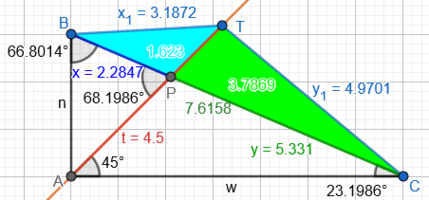
Wow thank you. If you hadn't pointed me in the correct direction I don't think I would have got that. I probably would have spotted my 7.6158/7.6518 error eventually - tired eyes!
I agree, my notation was horrible but that's how it all fit in my head and as I smashed it down on paper! I will definitely be improving that for clarity in the future. I normally use excel, a lot, for everything but i wanted to do this with the maths first, before I plug it into an automation; there is a means to an end for this.
I'm going to carry on with my worked example and make sure i come up with the same answers. Then I'll repeat the process until I'm familiar with it.
As an aside, which is the best forum to use for arcs/ellipses for hypotenuse instead of a straight line?
I agree, my notation was horrible but that's how it all fit in my head and as I smashed it down on paper! I will definitely be improving that for clarity in the future. I normally use excel, a lot, for everything but i wanted to do this with the maths first, before I plug it into an automation; there is a means to an end for this.
I'm going to carry on with my worked example and make sure i come up with the same answers. Then I'll repeat the process until I'm familiar with it.
As an aside, which is the best forum to use for arcs/ellipses for hypotenuse instead of a straight line?
Dr.Peterson
Elite Member
- Joined
- Nov 12, 2017
- Messages
- 16,117
It doesn't really matter; this one is fine. It's possible that would require calculus, but we can't know until we see it. (It also might be impossible apart from computer approximations.)As an aside, which is the best forum to use for arcs/ellipses for hypotenuse instead of a straight line?
I'd still like to see the real-life problem this is for, especially if you modify it. That may help us suggest a better model.
OK, here goes:
I'm an arboriculturist. I look at, study, survey and help protect trees for a living. I also enjoy (although I'm not the best at it) maths. I'm also keen on innovation and making my life more efficient.
Where I work (p.s. this is something I'm doing in my own time and not totally work related), we have survey software that collates dimension data for trees we look at. Those dimensions include the 4 main cardinal points and the 4 sub-cardinal points. The 4 main cardinal points are always filled in, and must be. The 4 sub-cardinal points are optional and will mostly be set to 0 (bare with me here).
The survey software is a web based tool located in the cloud that utilises a Global Information System (GIS) environment. Trees are mapped over aerials or topographical data uploaded into the software. When the survey is finished we are able to export the survey into an AutoCAD environment for post survey drawings and analysis.
The survey data is also exported as a comma delimited file (.csv) which is used to feed all our reports I have automated in Excel.
Ignore the black lines for the moment, they're just there for context. It's the blue 'tree' that is important.
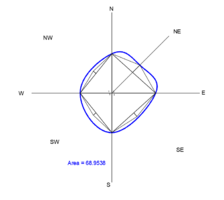
We are gradually entering a realm where tree canopy cover, carbon sequestration, replacement planting mitigation, Biodiversity Net Gain is becoming more front and centre in what I do and for the purposes if this exercise I'm specifically looking at tree canopy area. This is were these calculations are eventually going to be helpful.
For a bit of further context, GIS software and AutoCAD whilst being able to handle files created by one or the other, the are not the best (with the software I've currently got access to anyway) or most efficient when it comes to collating and comparing data records due to the way in which each dataset is handled (just believe me on that). Each software is great in it's own right but not necessarily together.
The blue tree above has been surveyed and recorded as having a canopy that extends N: 5m, S: 5m, E: 5.5m and W: 4m. It also has a sub-cardinal NE measurement of 5m. All other sub-cardinals are 0 and ignored.
The GIS survey software than 'plots' a tree shape using those dimensions. In the GIS software the tree canopy shape is a graphical representation; it is not a physical object. Only the tree 'point' (turned off here as not needed for this data) at the centre is a physical object. When the survey is exported to AutoCAD, the graphical representation in GIS, is coded into a what you see as the blue line. However, in GIS, things are 'drawn' on a globe, the export is flat i.e. 2D, so there is some smudging of the dimensions and tree canopy cardinal points in AutoCAD, are out by like ~0.01% i.e. N and S become 4.9714m and 4.9931m, E and W become 5.5311m and 4.0054m, NE is also 5.0011m.
I've also tried to test how the arcs between each cardinal point is plotted and drawn. They are not elliptical and there is no clear mathematical arc jumping out at me. Triangles was my next option to compare the differences between drawn trees and actual area using a triangle infill method. I was going to see if there was a similar % difference between the tree canopy shape in AutoCAD and 12 triangles (3 per cardinal quadrant).
The other issue i'm trying to get around is the sub-cardinals. They are not always filled in and when set to 0, they are ignored and the arc drawn from cardinal point to cardinal point.
What I'm trying to do is calculate an area for all 38K records of trees we have in our database without having to laboriously set this up manually in either AutoCAD or GIS. I can build an excel calculator that works out tree area based on the cardinal points. I can then just plug that calculator into the data and voila, tree area. I can then analyse that data to my hearts content.
There's probably bits I've missed but I'll continue to post with findings and questions as they arise if anyone is curious.
Thank you
I'm an arboriculturist. I look at, study, survey and help protect trees for a living. I also enjoy (although I'm not the best at it) maths. I'm also keen on innovation and making my life more efficient.
Where I work (p.s. this is something I'm doing in my own time and not totally work related), we have survey software that collates dimension data for trees we look at. Those dimensions include the 4 main cardinal points and the 4 sub-cardinal points. The 4 main cardinal points are always filled in, and must be. The 4 sub-cardinal points are optional and will mostly be set to 0 (bare with me here).
The survey software is a web based tool located in the cloud that utilises a Global Information System (GIS) environment. Trees are mapped over aerials or topographical data uploaded into the software. When the survey is finished we are able to export the survey into an AutoCAD environment for post survey drawings and analysis.
The survey data is also exported as a comma delimited file (.csv) which is used to feed all our reports I have automated in Excel.
Ignore the black lines for the moment, they're just there for context. It's the blue 'tree' that is important.

We are gradually entering a realm where tree canopy cover, carbon sequestration, replacement planting mitigation, Biodiversity Net Gain is becoming more front and centre in what I do and for the purposes if this exercise I'm specifically looking at tree canopy area. This is were these calculations are eventually going to be helpful.
For a bit of further context, GIS software and AutoCAD whilst being able to handle files created by one or the other, the are not the best (with the software I've currently got access to anyway) or most efficient when it comes to collating and comparing data records due to the way in which each dataset is handled (just believe me on that). Each software is great in it's own right but not necessarily together.
The blue tree above has been surveyed and recorded as having a canopy that extends N: 5m, S: 5m, E: 5.5m and W: 4m. It also has a sub-cardinal NE measurement of 5m. All other sub-cardinals are 0 and ignored.
The GIS survey software than 'plots' a tree shape using those dimensions. In the GIS software the tree canopy shape is a graphical representation; it is not a physical object. Only the tree 'point' (turned off here as not needed for this data) at the centre is a physical object. When the survey is exported to AutoCAD, the graphical representation in GIS, is coded into a what you see as the blue line. However, in GIS, things are 'drawn' on a globe, the export is flat i.e. 2D, so there is some smudging of the dimensions and tree canopy cardinal points in AutoCAD, are out by like ~0.01% i.e. N and S become 4.9714m and 4.9931m, E and W become 5.5311m and 4.0054m, NE is also 5.0011m.
I've also tried to test how the arcs between each cardinal point is plotted and drawn. They are not elliptical and there is no clear mathematical arc jumping out at me. Triangles was my next option to compare the differences between drawn trees and actual area using a triangle infill method. I was going to see if there was a similar % difference between the tree canopy shape in AutoCAD and 12 triangles (3 per cardinal quadrant).
The other issue i'm trying to get around is the sub-cardinals. They are not always filled in and when set to 0, they are ignored and the arc drawn from cardinal point to cardinal point.
What I'm trying to do is calculate an area for all 38K records of trees we have in our database without having to laboriously set this up manually in either AutoCAD or GIS. I can build an excel calculator that works out tree area based on the cardinal points. I can then just plug that calculator into the data and voila, tree area. I can then analyse that data to my hearts content.
There's probably bits I've missed but I'll continue to post with findings and questions as they arise if anyone is curious.
Thank you
Dr.Peterson
Elite Member
- Joined
- Nov 12, 2017
- Messages
- 16,117
Okay, so you're ultimately trying to estimate the area of the tree (blue curve) based only on 4 to 8 data points.
First, if you wanted to find the area of the polygon joining the known points, that's a lot easier than what you were asking.
I would just add the areas of the "sectors" between known points. The area of such a triangle is given by [imath]A=\frac{1}{2}ab\sin(\theta)[/imath], which in the green case is [imath]A=\frac{1}{2}ab\sin(90^\circ)=\frac{1}{2}ab[/imath], and in the yellow case is [imath]A=\frac{1}{2}bc\sin(45^\circ)=\frac{\sqrt{2}}{4}bc[/imath]. Just add those up for each pair of known "radii".
As for the shape of the curve drawn (which, of course, may have little to do with the actual shape of the tree!), I am guessing they might draw some sort of spline. They'd need to make some additional assumptions to do that, and I don't know how hard it would be to find an area formula for it.
But I don't think that's what you want, anyway; you just want a reasonable guess at the area of the tree, which is usually greater than the area of the polygon, by an unknown amount. It may turn out to be good enough to multiply the polygon area by some fixed adjustment factor that you could choose by working out the actual areas of a few sample trees (perhaps using some software that would just count pixels in the drawing?), and comparing ratios.
First, if you wanted to find the area of the polygon joining the known points, that's a lot easier than what you were asking.
I would just add the areas of the "sectors" between known points. The area of such a triangle is given by [imath]A=\frac{1}{2}ab\sin(\theta)[/imath], which in the green case is [imath]A=\frac{1}{2}ab\sin(90^\circ)=\frac{1}{2}ab[/imath], and in the yellow case is [imath]A=\frac{1}{2}bc\sin(45^\circ)=\frac{\sqrt{2}}{4}bc[/imath]. Just add those up for each pair of known "radii".
As for the shape of the curve drawn (which, of course, may have little to do with the actual shape of the tree!), I am guessing they might draw some sort of spline. They'd need to make some additional assumptions to do that, and I don't know how hard it would be to find an area formula for it.
But I don't think that's what you want, anyway; you just want a reasonable guess at the area of the tree, which is usually greater than the area of the polygon, by an unknown amount. It may turn out to be good enough to multiply the polygon area by some fixed adjustment factor that you could choose by working out the actual areas of a few sample trees (perhaps using some software that would just count pixels in the drawing?), and comparing ratios.
Indeed. It is actually a spline fit, but i don't know, and can't find out, the numbers behind that 'fit', hence why i'm trying to estimate.
I currently have the ratio adjustment at 68% i.e. the polygonal area is, more often than not, and on average, 68.96514558% smaller than the curved tree area. The only anomalies are where one of the 4 sub-cardinal points is blank. I might plug in your triangle sectors (above) rather then having in complex (in excel formula terms) bisecting of 90degree angles, and Law of Cosines to work out the area of each individual triangle and see how that works out.
Thank you.
I currently have the ratio adjustment at 68% i.e. the polygonal area is, more often than not, and on average, 68.96514558% smaller than the curved tree area. The only anomalies are where one of the 4 sub-cardinal points is blank. I might plug in your triangle sectors (above) rather then having in complex (in excel formula terms) bisecting of 90degree angles, and Law of Cosines to work out the area of each individual triangle and see how that works out.
Thank you.
Dr.Peterson
Elite Member
- Joined
- Nov 12, 2017
- Messages
- 16,117
Can you show how you apply this adjustment to the particular example you gave? I think you are again saying something different from what you mean! (E.g. what do you mean by saying the polygon area is 69% smaller than the actual area? It sounds very wrong.) Also, where did you get such a precise percentage?Indeed. It is actually a spline fit, but i don't know, and can't find out, the numbers behind that 'fit', hence why i'm trying to estimate.
I currently have the ratio adjustment at 68% i.e. the polygonal area is, more often than not, and on average, 68.96514558% smaller than the curved tree area. The only anomalies are where one of the 4 sub-cardinal points is blank. I might plug in your triangle sectors (above) rather then having in complex (in excel formula terms) bisecting of 90degree angles, and Law of Cosines to work out the area of each individual triangle and see how that works out.
Thank you.
And, yes, my calculation for the polygon should give exactly the result you would get by adding individual areas, with far less work.

